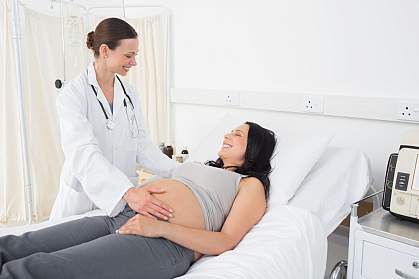You are here
August 30, 2022
Measuring placental health noninvasively
At a Glance
- An experimental system used laser light and ultrasound to measure changes in oxygen levels in the placenta.
- Some of the measurements were associated with pregnancy complications, indicating that the system could potentially help track maternal and fetal health.

During pregnancy, tissue called the placenta grows in the uterus along with the fetus. It brings oxygen and nutrients to the fetus and moves harmful waste and nutrients away. Problems with the placenta can harm the health of the mother, the fetus, or both.
Despite its importance, the placenta has proven difficult to monitor. Invasive techniques to measure the flow of oxygen to the placenta are risky and rarely used. Ultrasound imaging can monitor the health and growth of the fetus. But standard ultrasound techniques used at the bedside lack detail in images of small structures like blood vessels in the placenta.
An NIH-funded research team led by Drs. Arjun Yodh, Nadav Schwartz, and Lin Wang from the University of Pennsylvania has been developing tools to noninvasively measure placental health in real time. They designed an experimental system that uses both near-infrared lasers and ultrasound to measure oxygen levels in the placenta.
The laser light probe is based on a technology called diffuse optical spectroscopy, or DOS. It measures hemoglobin, the iron-based protein in blood that carries and releases oxygen into tissues. The system can distinguish how much of the hemoglobin holds oxygen molecules (oxyhemoglobin) and how much doesn't (deoxyhemoglobin). Previous DOS-based systems could only view about 2 centimeters below the skin—usually not deep enough to reach the placenta. The new system was designed to measure tissues more than 4 centimeters—about an inch and a half—deep, making placental measurements feasible.
The light probe was integrated with a probe from a standard commercial ultrasound system. Information from ultrasound could then be used to guide the light probe to various areas of the placenta. Results from proof-of-concept experiments using the system were published on August 15, 2022, in Nature Biomedical Engineering.
After confirming the performance of their system in laboratory models, the researchers performed early tests in 24 pregnant volunteers during their third trimester. The measurements of placental oxygen levels were consistent and repeatable.
Next, the team briefly gave supplemental oxygen to the volunteers to test the ability of the new system to directly measure changes in placental oxygen levels. In a small number of women, they also tested gently tilting the body in a way that increases blood flow to the placenta. In both cases, the system measured changes in oxygen levels in the placenta.
Nine of the women had one or more adverse outcomes during late pregnancy or birth. Eight experienced a problem with blood flow to the placenta called maternal vascular malperfusion. The team found that lower increases in placental oxyhemoglobin levels measured by the system during oxygen administration were associated with both adverse pregnancy outcomes and maternal vascular malperfusion.
“Without being able to study the placenta directly, we are relying on very indirect science,” Schwartz says. “This is a tool that helps us study the underlying physiology of pregnancy so we can more strategically study interventions that can help support good pregnancy outcomes.”
The team is currently refining the system to make it faster and easier to use. They are also testing it in volunteers in their second trimester to try to detect and address problems earlier in pregnancy.
—by Sharon Reynolds
Related Links
- Ultrasound Imaging Gets Small and Wearable
- Mother’s Gut Microbes May Influence Offspring’s Immunity
- Air Pollution Associated with Increase in NICU Admissions
- Microbiome Influences Risk of Preterm Birth
- 3-D Cell Placenta Model Mimics Development, Microbial Resistance
- Most Stillbirths Caused by Placental, Pregnancy Conditions
- Having Kids Later in Life: Healthy Pregnancies as You Age
- Pregnancy Check-Ups: Healthy Start for Mom and Baby
- Human Placenta Project
- Pregnancy
References: Non-invasive monitoring of blood oxygenation in human placentas via concurrent diffuse optical spectroscopy and ultrasound imaging. Wang L, Cochran JM, Ko T, Baker WB, Abramson K, He L, Busch DR, Kavuri V, Linn RL, Parry S, Yodh AG, Schwartz N. Nat Biomed Eng. 2022 Aug 15. doi: 10.1038/s41551-022-00913-2. Online ahead of print. PMID: 35970929.
Funding: NIH’s Eunice Kennedy Shriver National Institute of Child Health and Human Development (NICHD), National Institute of Biomedical Imaging and Bioengineering (NIBIB), National Institute of Neurological Disorders and Stroke (NINDS), and National Heart, Lung, and Blood Institute (NHLBI).
